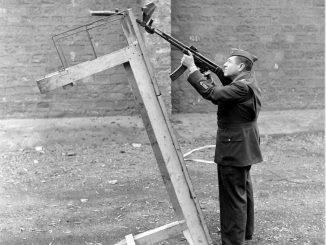When people see the AK-47 and the StG-44 side by side an know nothing about their internal mechanisms, the nearly universal assumption is that one is a copy of the other. The overall layout of the two rifles is strikingly similar, and one would reasonably make the assumption that Kalashnikov got his hands on a captured StG and simply rebuilt it in 7.62×39. This is, of course, not true.
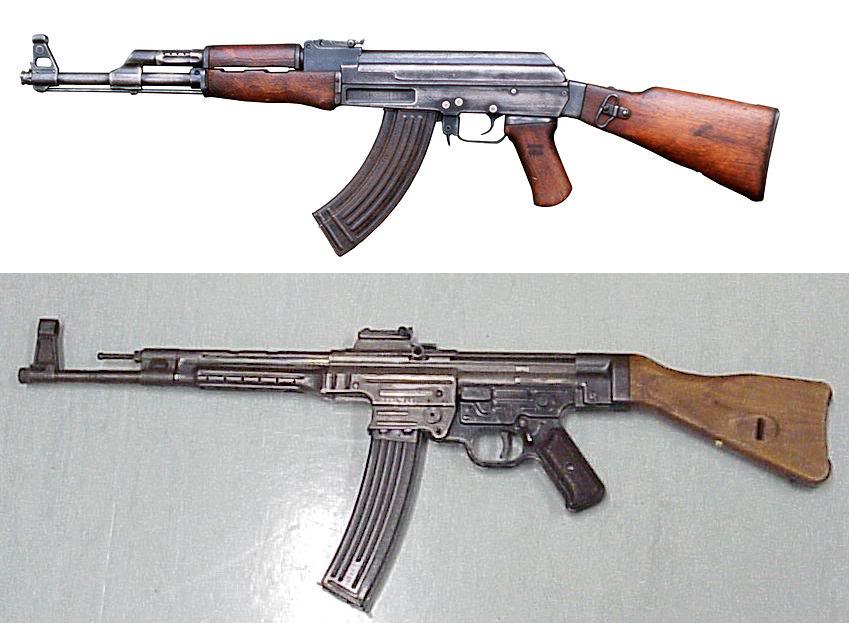
When presenting the same pair of rifles to a person who has a basic understanding of how they operate, you get a different reaction. They look similar because form follows function, and since one has a tilting bolt and the other has a rotating bolt they are actually unrelated. In some cases, you will get the counterclaim that if Kalashnikov copied anything, it was an American M1 Garand. This is also not quite an accurate claim.
So the question is, what is the true relationship between the AK and the StG?
Information on the question is held pretty close to the chest in Russia, so most of what I’m suggesting here is speculation…but I think the circumstantial evidence paints a pretty clear picture.
Let us first recognize that when the AK was being developed, the Great Patriotic War was only just won. Conditions on the Eastern front where the USSR and Germany had been fighting were horrific on a scale not remotely matched by the Western front of France and Italy. It would have been politically unthinkable for the government to publicly acknowledge the superiority of pretty much anything German. It is only in recent years that Kalashnikov has finally acknowledged receiving even the slightest assistance from German engineers (Schmeisser, specifically).
However, we know for a fact that at least four important small arms designers were brought into Russia after the war to work, having been given offers they couldn’t refuse (the US, UK, and France did the same thing to any important Germans they could get their hands on, of course). These four men were Schmeisser (primary designer of the MP-28 and StG-44), Horn (working on a simplified assault rifle at the end of the war), Barnitzke (designer at Gustloff, responsible for the VG1-5), and one of Barnitzke’s assistants. Schmeisser never spoke about what he did in Russia (and died in 1953), but Barnitzke did talk a little after returning home to Germany. He would not say what he did, but reported that his office from the Gustloff plant was moved whole to Russia and reassembled in perfect detail, right down to the placement of his pencils on his desk. Only the view out his window was different.
So what did these German small arms designers actually do for the USSR? They must have been put to work in the fields of specialty; anything else would be too wasteful even for Stalin to consider. And yet the only small arms development that took place at the time was the AK. The AK was the winning choice form a competitive field of several assault rifle designs, and so the Germans may well have been assigned to helping with some of the other designs initially. Once the winning rifle became clear, though, they would have been put to work on it.
One area of specialty where the Germans were far ahead of Russian engineers was complex metal stamping. Virtually all the late-war German small arms designs were primarily constructed of stampings, and complex ones to boot. Look at the details in the stamped receiver of an StG-44 (or MkB-42), and compare them to the very simple parts that comprised the PPS-43 submachine gun. The AK would not require as much detail as the German guns, but it would require more expertise that the Soviets had on hand. And this is where I propose that the legacy of the StG-44 had its impact on the AK. Not in initial design (which Kalashnikov has said was heavily influenced by the M1 Garand’s trigger mechanism and rotating bolt), but in its refinement and manufacturing.
If we look at the change between Sergeant Kalashnikov’s initial 1946 experimental model (which did well enough to win the selection contest) and the first production version of the AK-47, we see the influence of German experience.
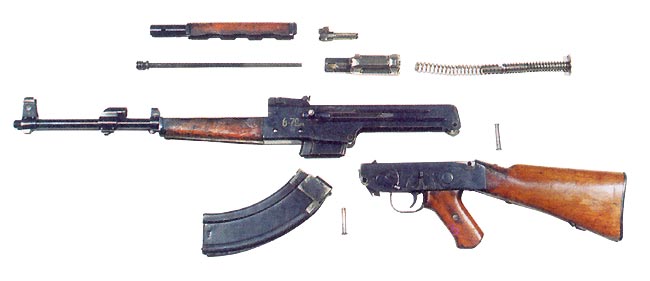
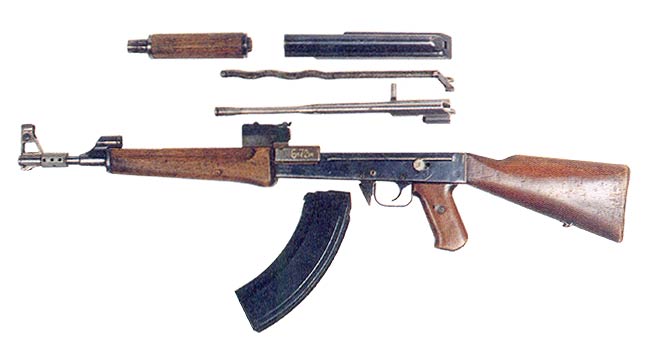
The receiver design changed significantly between these two, but look closer at some of the other details. The early gun had a separate gas piston, and a smooth gas tube, while the production design used a piston integral to the carrier and a ribbed gas tube for a better strength:weigh ratio. Both of these are features from the StG, and were definite improvements. I don’t have any knowledge of how the trunnion or barrel extension of the 1946 gun was fitted to the receiver, but by the first production models it had changed, and was very similar to the StG.
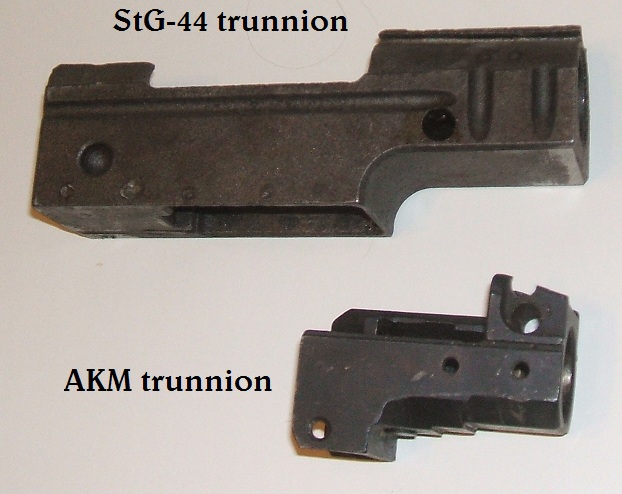
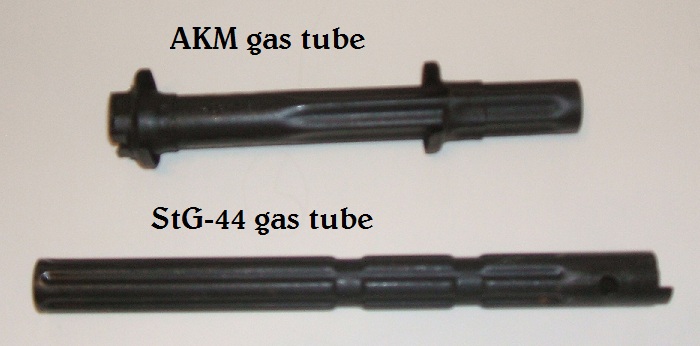
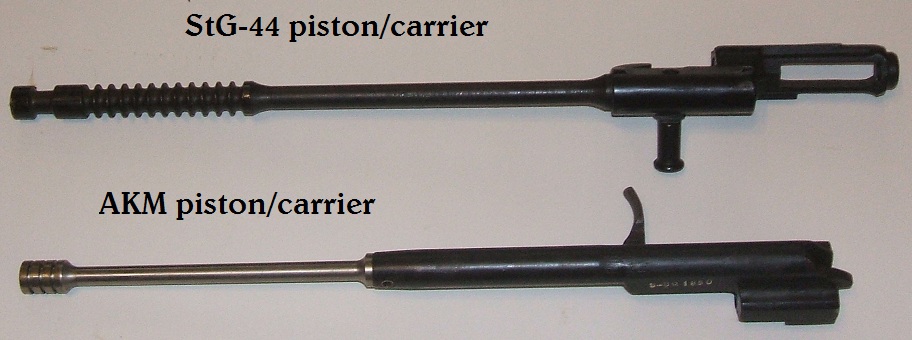
I’m using AKM parts in these photos because I don’t have Type I AK parts on hand to photograph – but with the exception of a cosmetically-different trunnion on the Type I AK, they are basically identical.
The German assistance resulted in improvements like these, and I expect with a lot of the factory tooling design needed to put the gun into mass production. There were still problems getting the process going, as the initial stamped receiver design ended up being difficult for the factories to get right, and had a very high scrap percentage. For this reason production was changed to a milled receiver in 1949 until the stamping difficulties were finally resolved and stamped production restarted in 1959. By that time, the USSR had finally developed its own native stamping expertise, as show by the followup PK machine gun design, using a stamped receiver significantly more complex than the AK.
I’m sure there are some folks reading this who have more detailed knowledge of the AK development process than I do, and I would be open to corrections of anything I have gotten wrong.


